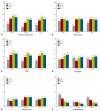Epidemiology of Heart Failure in Korea: Present and Future
- PMID: 27721857
- PMCID: PMC5054178
- DOI: 10.4070/kcj.2016.46.5.658
Epidemiology of Heart Failure in Korea: Present and Future
Abstract
Background and objectives: Heart failure (HF) is an important healthcare issue because of its high mortality, morbidity, and healthcare costs. The number of HF patients is increasing worldwide as a consequence of aging of the population. However, there are limited studies on the prevalence of HF in Korea. This study aimed to estimate the prevalence of HF, its comorbidities, and the projected population with HF in the future.
Materials and methods: The prevalence and comorbidity estimates of HF were determined using data from the 2002-2013 National Sample Cohort based on the National Health Information Database. We calculated the projected prevalence of HF by multiplying the estimated prevalence in 2013 by the projected population counts for 2015-2040.
Results: The prevalence of HF in Korea was estimated to be 1.53% in 2013. The prevalence of HF in Korea is expected to increase by 2-fold, from 1.60% in 2015 to 3.35% in 2040. By 2040, more than 1.7 million Koreans are expected to have HF. In terms of comorbid diseases of HF, ischemic heart disease, hypertension, and diabetes mellitus were common (45.4%, 43.6%, and 49.1% in 2013, respectively). The prevalence rates of arrhythmia, valvular disease, and cardiomyopathy in HF patients were approximately 22.6%, 5.6%, and 3.1% in 2013, respectively.
Conclusion: This is the first nationwide report in Korea to demonstrate the prevalence and comorbidities of HF. These data may be used for the prevention and management of HF in Korea.
Keywords: Comorbidity; Heart failure; Prevalence; Projection; Risk factor.
Conflict of interest statement
The authors have no financial conflicts of interest.
Figures




Similar articles
-
Heart Failure Statistics 2024 Update: A Report From the Korean Society of Heart Failure.Int J Heart Fail. 2024 Apr 18;6(2):56-69. doi: 10.36628/ijhf.2024.0010. eCollection 2024 Apr. Int J Heart Fail. 2024. PMID: 38694933 Free PMC article.
-
Prevalence and socio-economic burden of heart failure in an aging society of South Korea.BMC Cardiovasc Disord. 2016 Nov 10;16(1):215. doi: 10.1186/s12872-016-0404-2. BMC Cardiovasc Disord. 2016. PMID: 27832754 Free PMC article.
-
Temporal Trends of Hospitalized Patients with Heart Failure in Korea.Korean Circ J. 2017 Jan;47(1):16-24. doi: 10.4070/kcj.2016.0429. Epub 2016 Dec 29. Korean Circ J. 2017. PMID: 28154584 Free PMC article. Review.
-
The incremental economic burden of heart failure: A population-based investigation from South Korea.PLoS One. 2018 Dec 21;13(12):e0208731. doi: 10.1371/journal.pone.0208731. eCollection 2018. PLoS One. 2018. PMID: 30576328 Free PMC article.
-
Sex Differences in Heart Failure.Adv Exp Med Biol. 2018;1065:529-544. doi: 10.1007/978-3-319-77932-4_32. Adv Exp Med Biol. 2018. PMID: 30051405 Review.
Cited by
-
Comprehensive Trends and Patterns of Antihypertensive Prescriptions Using a Nationwide Claims Database in Korea.Clin Epidemiol. 2020 Sep 11;12:963-975. doi: 10.2147/CLEP.S265966. eCollection 2020. Clin Epidemiol. 2020. PMID: 32982461 Free PMC article.
-
Validation of the MAGGIC (Meta-Analysis Global Group in Chronic Heart Failure) heart failure risk score and the effect of adding natriuretic peptide for predicting mortality after discharge in hospitalized patients with heart failure.PLoS One. 2018 Nov 28;13(11):e0206380. doi: 10.1371/journal.pone.0206380. eCollection 2018. PLoS One. 2018. PMID: 30485284 Free PMC article.
-
Palliative and end-of-life care for heart failure patients in an aging society.Korean J Intern Med. 2018 Nov;33(6):1039-1049. doi: 10.3904/kjim.2018.106. Epub 2018 May 23. Korean J Intern Med. 2018. PMID: 29779361 Free PMC article. Review.
-
Arterial Stiffness and Heart Failure With Preserved Ejection Fraction.J Korean Med Sci. 2024 Jun 17;39(23):e195. doi: 10.3346/jkms.2024.39.e195. J Korean Med Sci. 2024. PMID: 38887204 Free PMC article. Review.
-
Heart Failure Epidemic: an Expected Phenomenon.Korean Circ J. 2016 Sep;46(5):610-612. doi: 10.4070/kcj.2016.46.5.610. Epub 2016 Sep 28. Korean Circ J. 2016. PMID: 27721849 Free PMC article. No abstract available.
References
-
- Mozaffarian D, Benjamin EJ, Go AS, et al. Heart disease and stroke statistics--2015 update: a report from the American Heart Association. Circulation. 2015;131:e29–e322. - PubMed
-
- Okamoto H, Kitabatake A. The epidemiology of heart failure in Japan. Nihon Rinsho. 2003;61:709–714. - PubMed
-
- Okura Y, Ramadan MM, Ohno Y, et al. Impending epidemic: Future projection of heart failure in Japan to the year 2055. Circ J. 2008;72:489–491. - PubMed
-
- Shiba N, Nochioka K, Miura M, Kohno H, Shimokawa H CHART-2 Investigators. Trend of westernization of etiology and clinical characteristics of heart failure patients in Japan--first report from the CHART-2 study. Circ J. 2011;75:823–833. - PubMed
LinkOut - more resources
Full Text Sources
Other Literature Sources
Medical
Research Materials
Miscellaneous

